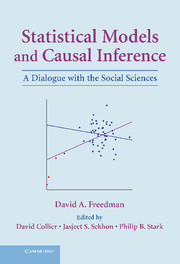Book contents
- Frontmatter
- Contents
- Preface
- Editors' Introduction: Inference and Shoe Leather
- Part I Statistical Modeling: Foundations and Limitations
- Part II Studies in Political Science, Public Policy, and Epidemiology
- 4 Methods for Census 2000 and Statistical Adjustments
- 5 On “Solutions” to the Ecological Inference Problem
- 6 Rejoinder to King
- 7 Black Ravens, White Shoes, and Case Selection: Inference with Categorical Variables
- 8 What is the Chance of an Earthquake?
- 9 Salt and Blood Pressure: Conventional Wisdom Reconsidered
- 10 The Swine Flu Vaccine and Guillain-Barré Syndrome: A Case Study in Relative Risk and Specific Causation
- 11 Survival Analysis: An Epidemiological Hazard?
- Part III New Developments: Progress or Regress?
- Part IV Shoe Leather Revisited
- References and Further Reading
- Index
9 - Salt and Blood Pressure: Conventional Wisdom Reconsidered
Published online by Cambridge University Press: 05 June 2012
- Frontmatter
- Contents
- Preface
- Editors' Introduction: Inference and Shoe Leather
- Part I Statistical Modeling: Foundations and Limitations
- Part II Studies in Political Science, Public Policy, and Epidemiology
- 4 Methods for Census 2000 and Statistical Adjustments
- 5 On “Solutions” to the Ecological Inference Problem
- 6 Rejoinder to King
- 7 Black Ravens, White Shoes, and Case Selection: Inference with Categorical Variables
- 8 What is the Chance of an Earthquake?
- 9 Salt and Blood Pressure: Conventional Wisdom Reconsidered
- 10 The Swine Flu Vaccine and Guillain-Barré Syndrome: A Case Study in Relative Risk and Specific Causation
- 11 Survival Analysis: An Epidemiological Hazard?
- Part III New Developments: Progress or Regress?
- Part IV Shoe Leather Revisited
- References and Further Reading
- Index
Summary
Abstract. The “salt hypothesis” is that higher levels of salt in the diet lead to higher levels of blood pressure, increasing the risk of cardiovascular disease. Intersalt, a cross-sectional study of salt levels and blood pressures in fifty-two populations, is often cited to support the salt hypothesis, but the data are somewhat contradictory. Four of the populations (Kenya, Papua, and two Indian tribes in Brazil) do have low levels of salt and blood pressure. Across the other forty-eight populations, however, blood pressures go down as salt levels go up–contradicting the hypothesis. Experimental evidence suggests that the effect of a large reduction in salt intake on blood pressure is modest and that health consequences remain to be determined. Funding agencies and medical journals have taken a stronger position favoring the salt hypothesis than is warranted, raising questions about the interaction between the policy process and science.
It is widely believed that dietary salt leads to increased blood pressure and higher risks of heart attack or stroke. This is the “salt hypothesis.” The corollary is that salt intake should be drastically reduced. There are three main kinds of evidence: (i) animal experiments, (ii) observational studies on humans, and (iii) human experiments. Animal experiments are beyond the scope of the present chapter, although we give a telegraphic summary of results. A major observational study cited by those who favor salt reduction is Intersalt (1986, 1988).
- Type
- Chapter
- Information
- Statistical Models and Causal InferenceA Dialogue with the Social Sciences, pp. 131 - 150Publisher: Cambridge University PressPrint publication year: 2009

